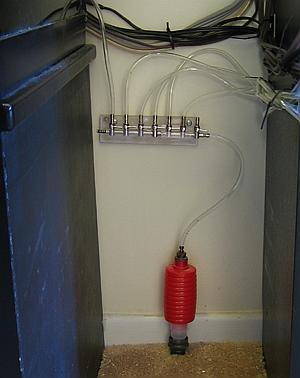If you want to make this more precise for your setup, test for nitrates - they are the end product of fish food. If you have healthy fast-growing plants, they want some nitrates as fertilizer, in fact plant enthusiasts often add them for that reason. However, few fresh-water fish will be healthy with a level above 100 ppm NO3. For invertebrates such as snails, keep it below 20.
Whenever you decide to do it, changing water can be a messy job at the best of times. A carpeted location adds to the potential problems. As a result, many of us don't change water as often as we should. All of us search for ways to maximize convenience and minimize mess when doing it.
One product used to be a good solution for large tanks: the Meridian automatic water changer. It uses the Venturi effect of a jet of water to suck the old water out of an aquarium while replacing it with new. Unfortunately it has several major problems. Obviously it can't be used with marine tanks. The water change rate is too large for small aquaria, disrupting temperature as it works. Finally, most municipal water is now sterilized with chloramines, which do not degas the way pure chlorine did, which is what the Meridian relied on. However, if you are running off well water that has no chloramines added or live in one of the few municipalities that still uses pure chlorine, and you have large fresh water tanks (at least 100 l) populated with fish that are fairly insensitive to temperature shock, it works.
Much of the mess occurs when siphoning out old water, when starting the siphon in particular. Lots of us know the taste of our aquarium water all too well from doing it! There is a less messy solution: siphon starters. These are a squeezable bulb with built-in valves - when the bulb is squeezed, enough water is sucked up to start the siphon going, then the valves automatically open to allow the water to flow. They must be replaced as soon as the slightest sign of stress is visible on the bulb i.e. before they crack and dump water all over the place. They work better once the valves are wet so they seal properly. And some don't have a top valve, so you have to block the hose above by squeezing it before you squeeze the bulb. But, they work.
The next problem is to get the old water away from the site without slopping it all over the carpet. A suitable drain right next to the aquaria is great. If you own your home and have a basement below your aquarium site, you can make one like mine: drill a small hole in the floor for a garden hose which empties into a suitable drain in the floor below (a laundry tub is easiest). If you have many tanks, you can connect an air hose to each and lead the hoses down to valves to allow easy selection of the tank to be emptied, as shown at right. (The valves are sold for air, but work fine with water.) For convenience, I mount the siphon hoses in the tanks so they automatically stop when about 10% of the water has been removed.
Now, to replace the water.
Most aquaria are kept at a much higher temperature than most water out of the tap. Ottawa is an exception as our water comes from a shallow river. Tap water here averages 10°C in winter but 26 in summer; my aquaria are at 25. Most are small (35 l) so my solution is to fill a 4 l juice bottle (the largest container that fits in my microwave), then give it enough time (5 minutes winter to zero in summer) to bring it to tank temperature.
Ottawa municipal water (excepting the part that comes from wells) is fairly soft, typically 50 ppm CaCO3, so I don't have to correct that. But our 0.8 ppm monochloramine must be deactivated: 1 drop with my brand of neutralizer. (It contains sodium hydroxymethane sulfinate at a recommended dose of 1 ml per 10 US gallons for 2.5 ppm monochloramine. That works out to 34 µl for my 4 l container. My drop bottle produces drops of about 40 µl.)
Finally, Ottawa water is very alkaline, usually well over 9 pH; 2 drops (80 µl) hydrochloric acid corrects that to the 6.8 pH gouramis prefer. (Hydrochloric acid is sold here for swimming pool use; labelled as 20 Be muriatic acid, it is 1 mol/l HCl, 31.5%. It sells for $2.39/l; aquarium pH-lowering acid is typically a quarter that strength and costs $8.89 for 118 ml - over 100x the cost.)
Then, I carry the water to the tank area. It's slow, but no mess.

siphon starter and valves

the tank end